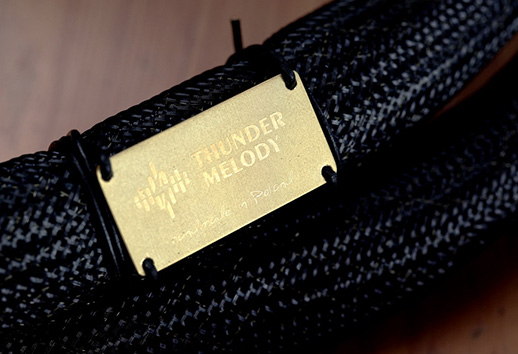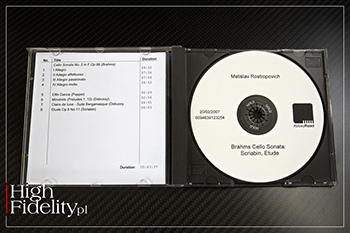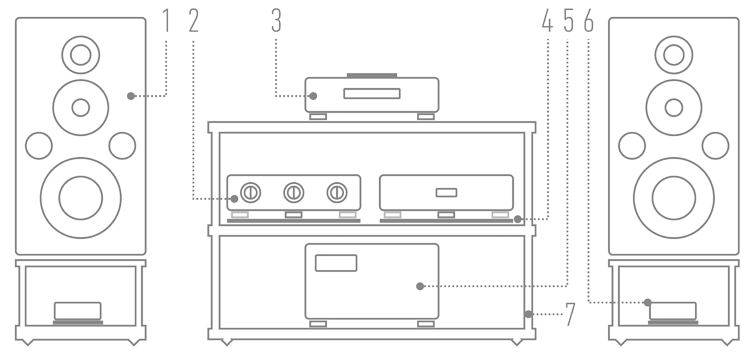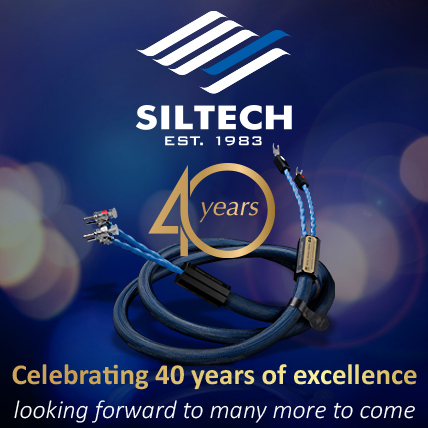|
POWER CABLE AC THUNDER MELODY
Manufacturer: INNOVACOM sp. z o.o. |

|
Review
Text by WOJCIECH PACUŁA |

|
No 254 July 1, 2025 |
|
˻ PREMIERE ˼
YOU HAVE PROBABLY NOTICED, maybe even before I did, but for the sake of argument I will say: for some time Polish companies have been pushing their way into top echelon of audio and they do it without complexes. Not only that, also in the middle price ranges you can find a lot of very good Made in Poland products, but the high-end seems to be the place where engineers from this country in Central Europe, as Felix zu Schwarzenberg (German: Mitteleuropa) spoke of it, and Milan Kundera understood it in contemporary terms, feel best. What was born as yet another imperial pipe dream has spawned a new quality, though not as the creator of the term imagined. 
Take a look at any of the major English-language - because it's so happened that Polish audio is mainly associated with those countries - audio magazines, with the American monthly Stereophile at the top, and you'll find not one, not two, but many ads in which Polish brands are mentioned. The same is true of tests. There is not a month that somewhere in the West - since we are at neo-imperialisms - there has not appeared a review, an interview, a description of a product that originated between the Bug and the Oder. That's J.Sikora, Ferrum, Felix Audio, WK Audio, Fezz Audio and others. And when you add the presence of these brands, as well as JPLAY, XACT and JCAT, in Japanese and Korean magazines, the picture is even more accurate. You will not find Thunder Melody there. This is because it is a small company, a boutique one, you might say. It doesn't have an advertising presence anywhere on the web or in print, and its products are aimed at people who know exactly what they want and are usually not guided by advertisements. According to Mr. Ras, one of its two pillars, listening is conclusive, after which, he adds, their products almost always stay with customers. Which is helped by the fact that the price of its top series includes a service called Personal Concierge, that is, delivery to the customer, installation and “coffee with music,” as I read in an email sent to us. ▌ Atto Speakers Black THUNDER MELODY'S LINEUP is divided into several levels: Silver, Gold and Black. We start with the Silver series, move to Gold and finally to Black. In the latter, as the designers say, there is no upper price limit, because you can then use all the techniques developed by the company. Interestingly, you can buy a given product of any of the cheaper versions, and after some time, have it upgraded to a higher version. This allows you to save money and stay within the “sound space” proposed by this company. This time we go straight for the highest version of the most expensive speaker cable in the new series, the Atto Speakers Black model. | A few simple words… KONRAD RAŚ 
ATTO IS A LINE we have taken a new engineering approach for, a “maximalist” approach in the very design of the product architecture. This approach, is similar to the idea of “splitting hairs into four” - only that in this case in an absolutely non-pejorative, but positive and measurable in effects sense. Such an approach naturally imposes the need to take care of more and more branching micro-issues, which results in the fruits of the effect, but also in increasing complexity and cost. The word “approach” is repeated here every sentence. - crucial to this family of solutions. ATTO is an order of magnitude of 10 to the power of -18. FEMTO is an order of magnitude of 10 to the power of -15. There is a reason we use such small measures in the names of our product families. Already the previous products in the Femto line were based on holistic, powerful signal de-noising. It was expensive to make, but we tried to control the final price, especially being a new player in the audio market. We managed to create products that have no aftermarket, in the sense that our customers do not resell them. However, their owners, especially of the highest models, asked if it was possible to “get something more out of it.” We knew that there were reserves in the technologies we were using, but they were beyond our budget. However, this gave us the impetus to go further, and further than FEMTO is ATTO. And it's as much as one unit of measurement smaller, which means three orders of magnitude, or 1,000 times smaller signals. 
The effect we wanted to achieve, figuratively speaking, was to gather the maximum amount of acoustic information in a body on the stage, so that it is illuminated and the objects are independent of each other. And this is a large-scale form of object focus, related to the “shadow” cast on the band by low frequencies, with independent objects illuminated by something like “back-lighting” in photography. The references to the image, to live theater, are not coincidental - acoustics in sound and shadow play in image are the same attribute of perception of real spatiality. Atto is meant to point in this direction and allow entry into this kind of presentation. For those who have something to do with photography, it would be analogous to taking a picture with a “bright lens”, with underexposure of the shot, which requires increasing the exposure time so that there is a chance to collect even single photons, i.e., maximum use of “ambient light”, without supporting lamps (vide photo of millions of stars on a long exposure time). In photography, this is not difficult, although tedious and requires attention. In audio, however, we have the signal on the fly, there is no time to “collect photons” - we need to get to them immediately. And this is what Atto serves, and to some extent Femto has already served. 
The first tests confirmed that this approach deserves a new name. The first representative of the Atto family is the Atto Speakers speaker cable in Black version. These cables will only be offered in Gold and Black versions. The Gold version is being upgraded by us to Black upon customer request. With that said, the Femto and Atto family lines are not compatible with each other, that is, it is not possible to switch from Femto to Atto models. KR ATTO SPEAKERS SPEAKER CABLE is made of - as it reads - Thunder Melody-selected copper, and the total conductor cross-section is 16 mm2. That's a lot, but the cables are surprisingly flexible - except for the terminated endings, terminated with bananas or WBT spades from the Ag series. The standard configuration is banana → spade, but you can order other configuration of your choice; the company prefers banana plugs on both sides. Mr. Ras mentioned noise minimization - it is, in fact, a central technology in all of the company's products. In cables, one technique that helps with this is shielding. So it's not surprising that Atto Speakers is a shielded cable. Unusually, the shielding has been brought out with a separate silver strip (Duelund’s), with a banana plug that plugs into the artificial ground. 
Since the speaker cable has a ground tapping, and this is an important part of the design, the company suggests using the best available ground conditioner or connecting it to PE ground, all with the best possible cables for these purposes. If one does not have the ability to ground them, then, as the manufacturer recommends, grounding should be connected to speaker ground, preferably at the amplifier, as a last resort on the speaker side. Grounds should not be without potential (some form of ground). It reads:
An important aspect of working with this cable is timing. Regardless of the grounding used, its movement is expected to affect the background noise floor of the entire system, so “it requires time to stabilize not only the electrostatics of the cable stress, but also the overall «noise floor»” The time we should allocate to minimize the statistical stress is an hour-two. Over time, after the cable has stabilized mechanically, i.e. after the potentials, electrostatics, capacitances, etc., have equalized, these changes are expected to have less impact on the sound. Therefore, the manufacturer suggests a specific way of listening to the cable:
Regardless of which method one adopts, the company asks for a test, which it says is the “icing on the cake”: leaving the connected cable until the morning, without touching it, unplugging or re-plugging it, and only then listen to the same material as you did a day before. “It's really worth it to see how strongly the effect changes the very next day, how it matures, solidifies and what kind of direction it takes,” adds Mr. Raś. The cables come in nice velvet cases. Also included is a plaque with a creator-signed certificate. Its back is made of the “armored” plywood that Thunder Melody uses for its equipment and accessories, and the plaque is made of polished brass, matted with laser. A similar small metal plate has been attached with a thong to the cable. This is a nod to customers, and a little bit to me as well, since I had previously complained about the lack of such features, important to the customer. 
From a conversation with the designer, it seems that any metal element in the cable environment without a dissipated potential changes the sound for the worse, which is why he hasn't used anything like that so far. The same is true of cable splitters. This is one of the few places where you can mark a product with a logo, a name and add chic. In the cable we are testing there are none, and their place is taken by the usual, boring heat shrink sleeve. Boring - but not for the designers. They say that it was chosen from many others and is not random, and that replacing it with something “nicer” changes the sound for the worse. As we read, “the geometry and all engineering aspects are our know-how and are an accumulation of our developed techniques for managing anti-vibration, signal transmission and electromagnetism.” Cumulative cable assembly time is expected to be about 40-hours. ▌ SOUND HOW WE LISTENED • The Thunder Melody Atto Speaker Black speaker cable was tested in a HIGH FIDELITY reference system. It connected a Soulution 710 power amplifier and Harbeth M40.1 loudspeakers, and was terminated with banana plugs on the amplifier side, and spades on the speakers side. It lay not on the floor, but on Acoustic Revive RCI-3 stands, along with a reference cable - Siltech Triple Crown. The ground was plugged into a Nordost QRT QKORE 6 ground, more → HERE. 
The comparison took the form of AAA/BBB and BBB/AAA with the familiar A and B. The listening excerpts of the songs were 1 to 2 minutes long. |
» RECORDINGS USED FOR THE TEST ⸜ a selection
⸜ ROSTROPOVICH, ALEXANDER DEDYUKHIN, Brahms, Popper, Debussy, Scriabin, «Sonata In F Major, Op. 99»/«Elfin Dance»/«Minstrels & Clair De Lun»/«Etude, Op. 8 No. 11», EMI Records, Master CD-R ⸜ 1959/2017 (2007). CABLES, LOUDSPEAKERS, ELECTRONICS, other components of an audio system - none of them do not exist on their own. In the sense that we perceive the components of an audio system always in context. And for a reviewer, the most important context is the reference system. Called “reference” it is not at all necessarily the best possible. It's a paradox, but contrary to the habit of language users, “reference” does not necessarily speak of something best, but of “the best available” and of a reference point. 
Therefore, over the years I have used good but not at all top audio products, and yet I was easily able to judge the quality of the products compared to them in the test. Confidence in the ratings came from the ability to extrapolate the results of previous comparisons to a new product. Knowing all this, however, as my reference system “got fatter” and stabilized at a really high level, I became accustomed to its sound and began to look at everything in the test “from above,” from the side of top-shelf products. Therefore, when I plugged in the new cables in place of my reference cables, the Siltech Triple Crown, it was, I must confess, a search for what these new cables are worse at. And it wasn't difficult at all. After all, we're talking about a reference created as a result of years of research with high-level specialists, huge amounts of money spent on measurement and design systems, making the cables, etc. With the Thunder Melody cable, however, I heard something that did not at all set the reference-newcomer relationship in a preconceived and expected place. The Polish cable turned out to be simply perfect. The thing I noticed right at the beginning of the listening was the absolute “darkness” behind the sounds. Not in between, because there was a lot going on there, but behind. That is, the sounds were shown in a clear way, in three dimensions. But also without cutting them out of the background, with this background they formed a whole. They were also big and massive. But the mass was not clumsy, but rather focused on the sound and on the music. Also associated with the “darkness” was an incredible culture in the delivery of the sound attack. MSTISŁAW ROSTROPOWICZ's cello on the Brahm’s Master CD-R, prepared at Abbey Road studios by sound engineer Ian Jones, sounded deep, smooth, dark. Siltech served them up in a clearer way. That is, in a way in which the attack was clearer and more strongly illuminated, But it was by no means more natural - it was simply different. The Polish cable conveyed the same material in a much more velvety way, though not at all less resolving. | Our albums ⸜ ROSTROPOVICH, ALEXANDER DEDYUKHIN EMI Records, Master CD-R ⸜ 1959/2017 (2007) 
A RECORDING of Brahms' 2nd Cello Sonata in F Major, Op. 99 made by Mstislav Rostropovich and Alexander Dedyukhin is known from a recording released on LP in 1959. The title recording is accompanied by three others, composed by Popper, Debussy and Scriabin. This album was released on the His Master's Voice label (ALP 1690). His Master's Voice was a British record label founded in 1909, which became EMI Records. Its defining feature was the Nipper dog in its logo. This material was recorded on June 26-27, 1957, at Studio No.3, at London's Abbey Road Studios. The sound engineer (Balance Engineer) was Neville Boyling, and the producer was Lawrence Collingwood. This studio was the smallest in the entire complex, but it was suitable for recording small classical and pop bands. The Rolling Stones, for example, played in it. At the time, it was equipped with a REED tube console of their own manufacture and a BMR2 tape recorder - a powerful 300-kilogram beast. There were no special reverberation rooms or portable EMT systems back then, so the sound of the record in question is quite dry and direct. The album has been reissued only once, on CD, in 2017 with a remaster by Christopher Hénault. All the more interesting is the CD we are showing you. It's a master CD-R burned in the Abbey Road studios by Ian Jones. He was educated at the Royal Academy of Music, where he studied cello and guitar - passions he has retained to this day, as his official bio reads. He began his career in the royalty department at EMI, and then used his knowledge of their classic catalog as an engineer at Abbey Road in the 1980s. Today, he is still one of the mastering engineers at Abbey Road. 
The album is interesting because it was burned in 2007. Perhaps by then EMI was already thinking of reissuing it. Perhaps it is a so-called “Flat transfer,” that is, a ripping from master tape without mastering. As you can see, we had to wait another ten years, before it was released with the logo of the new owner of the His Master's Voice brand, Warner Music Group. ● THIS IS AN INCREDIBLY well-differentiating cable, although it does it differently than Siltech. It runs the sound on the softer side of attack. It's still a very similar understanding of sound, but taking a different path, parallel to it. With less focus on the energy contained in the first phase, and locating it in the sustain phase thus giving us a different perspective from which we see, for example, the drums and double bass from the MAYO NAKANO PIANO TRIO Miwaku CD. They were smoother, darker, more fluid, and slightly less illuminated with the Atto Speaker Black. 
Interestingly, after switching back to the Siltech, I didn't miss it at all, as I got in turn a faster entry into the sound, clearer edge differentiation, as well as a deeper stage. And again, after another switch to Thunder Melody I didn't miss it, which was given by Siltech. The incredible smoothness, while maintaining the excellent focus of the sound, that the Polish cable offered drew my attention towards other aspects, without an automatic division in my head between “better” and “worse”. In absolute terms, the Dutch cable has advantages that I've never heard before and nowhere else except for the Master Crown version. It's ultimate resolution and incredible depth of stage. But the tested cable played in those aspects I mentioned, more like Edwin van der Kley's current top cable than the Triple Crown. As you can see, progress can happen on many levels, and on each level it can run at its own pace. The Miwako album was recorded in DSD and burned on Extreme Hard Glass CD-R. It is a top combination. Its peculiarity is a slight thickening in the low midrange, resulting from the suppression of reflected sounds. But already the brass sounds remarkably sonorous and dense. Thunder Melody demonstrated this flawlessly. Especially since it skillfully balances between what is strong and what is soft. Therefore, even rather bright recordings with heavily distorted guitar sound, not-so-clean percussion and vocals released far into the stage, will be shown in an orderly yet energetic way. When I say that, I'm referring to DEREK AND THE DOMINOS Layla And Other Assorted Love Songs on the 2013 Platinum SHM-CD version and Clapton's vocals. It sounds as if it was recorded during a concert. it is quite screamy and lacks a clear “body”. The Polish cable showed it quickly and decidedly. While doing so, it did not exacerbate the problems of the recording. Stereoscopy was not as deep as with the reference cable, but we've already established that - Atto Speaker Black focuses mostly on the “here and now”. Besides, compared to most other cables, it will still excel in this aspect. Interesting, but it's a direction similar to that taken in their Flux iLLumi SP cables by Verictum's designers and in the Desire model by Audio Phonique, two other Polish manufacturers. In both cases, the idea was to have a pleasant, incredibly immersive sound, in which there is no room for noisiness or brightness. The Thunder Melody cable can be placed in the same collection. But it is not identical with them. It was with Clapton's album that one could hear that it pushed forward the attack of the sound more strongly, that it energized the upper midrange more clearly going - in this comparison - in the direction of the Siltech. It's important to know that it's still a “velvety” sound. Even just after the penultimate track on the album, 13 ˺ Layla, in ˻ 14 ˺ Thorn Tree in the Garden, by Boby Whitlock, the acoustic guitar was shown thick, low, dark, as were his vocals. This was also the case with the song ˻ 1 ˺ Remember from HANK MOBLEY's Soul Station album, as released in 2010 on XRCD24 - this time it was all about the saxophone. The leader's instrument had a velvety sheen, and it was at the same time lively, feisty, powerful. This is not a pillow playing, nor the bar one, but rather part of the ritual, trance-like playing. The Polish cable shows such nuances effortlessly. ▌ Summary AS I SAY, POLISH COMPANIES don't have complexes anymore. They are just as good, and often better, than their “of the world” counterparts. The comparison of the Thunder Melody Atto Speaker Black cable with the Siltech Triple Crown was a good example of this. The Dutch cable is better, but these are not big differences and not in everything. For the Polish cable brings an incredibly deep sound with excellent focus and differentiation. It's presentation is dynamically energetic, so that the pianos in the cover of the ˻ 1 ˺ Enjoy The Silence by Depeche Mode in the jazz version from the album Jazz At Berlin Philharmonic XVI - Piano Night II sounded perfectly deep and powerful at the same time. 
The tested cable does not accentuate the extremes of the band, we focus our attention on the midrange. But just because we don't focus doesn't mean the cable doesn't show them. And the ˻ 1 ˺ Tokyo Lift (5am), the summer song by CAUCTION CLAY, and the excellent remix of the track Na Le - Phase Remix by OMIKI sounded remarkably “wide” indeed. Both, in terms of stereoscopy, and dynamics, and bandwidth. The low sounds had something of the softness we expect from tube equipment and vinyl. There was energy, there was extension, there was a “compression” of the sound in my room that made me feel like I was sitting inside the sound, not outside. The thing is, as usual, in the accents placed a bit elsewhere than in the reference cable. The cable in question guarantees incredibly satisfying listening. In a way, it forgives recordings their problems. It doesn't cover them up, doesn't extinguish them, but rather draws our attention to what's good, Like the tangibility of SKUNK ANANSIE's vocals in ˻ 4 ˺ Lost and Found, to the strong brass in the left channel, to the cranked up bass. And when the acoustic guitars sounded from ˻ 4 ˺ Goin’ Back by NEIL YOUNG, you could sit back and absorb. These are top cables. ● 
THIS TEST HAS BEEN DESIGNED ACCORDING TO THE GUIDELINES adopted by the Association of International Audiophile Publications, an international audio press association concerned with ethical and professional standards in our industry, of which HIGH FIDELITY is a founding member. More about the association and its constituent titles → HERE. |
|
Reference system 2025 |
|
 1) Loudspeakers: HARBETH M40.1 |REVIEW| 2) Line preamplifier: AYON AUDIO Spheris III Linestage |REVIEW| 3) Super Audio CD Player: AYON AUDIO CD-35 HF Edition No. 01/50 |REVIEW| 4) Stands (loudspeakers): ACOUSTIC REVIVE (custom) |ABOUT| 5) Power amplifier: SOULUTION 710 6) Loudspeaker filter: SPEC REAL-SOUND PROCESSOR RSP-AZ9EX (prototype) |REVIEW| 7) Hi-Fi rack: Hi-Fi rack: finite elemente MASTER REFERENCE PAGODE EDITION Mk II, more → HERE |
|

|
Cables Analog interconnect SACD Player - Line preamplifier: SILTECH Triple Crown (1 m) |ABOUT|» ANALOG INTERCONNECT Line preamplifier → Power amplifier: Siltech ROYAL SINLGE CROWN RCA; review → HERE Speaker cable: SILTECH Triple Crown (2.5 m) |ABOUT| |

|
AC Power Power cable | Mains Power Distribution Block - SACD Player: SILTECH Triple CrownPower (2 m) |ARTICLE| » POWER CABLE Mains Power Distribution Block → Line preamplifier: Acoustic Revive ABSOLUTE-POWER CORD, review → HERE » POWER CABLE Mains Power Distribution Block → Power amplifier: Acoustic Revive ABSOLUTE-POWER CORD, review → HERE Power cable | Power Receptacle - Mains Power Distribution Block: ACROLINK Mexcel 7N-PC9500 (2 m) |ARTICLE| Power Receptacle: Acoustic Revive RTP-4eu ULTIMATE |REVIEW| » ANTI-VIBRATION PLATFORM under Acoustic Revive RTP-4eu ULTIMATE: Graphite Audio CLASSIC 100 ULTRA, review → HERE Power Supply Conditioner: Acoustic Revive RPC-1 |REVIEW| Power Supply Conditioner: Acoustic Revive RAS-14 Triple-C |REVIEW| Passive filter EMI/RFI: VERICTUM Block |REVIEW| |

|
Anti-vibration Speaker stands: ACOUSTIC REVIVE (custom)Hi-Fi rack: finite elemente MASTER REFERENCE PAGODE EDITION Mk II, more → HERE Anti-vibration platforms: ACOUSTIC REVIVE RAF-48H |ARTICLE| » ANTI-VIBRATIONAL FEET: |

|
Analogue Phono preamplifier: Phono cartridges:
Clamp: PATHE WINGS Titanium PW-Ti 770 | Limited Edition Record mats:
|

|
Headphones » HEADPHONE AMPLIFIER: Leben CS-600X, review → HEREHeadphones: Headphone Cables: Forza AudioWorks NOIR HYBRID HPC |
main page | archive | contact | kts
© 2009 HighFidelity, design by PikselStudio,
projektowanie stron www: Indecity








